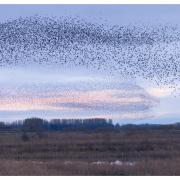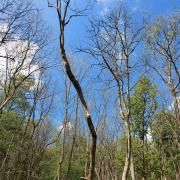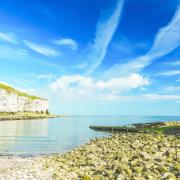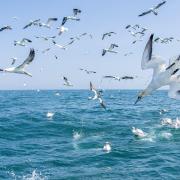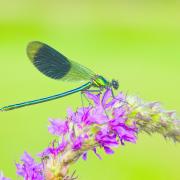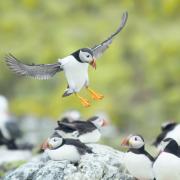Could East Yorkshire be sitting on an economic boost worth £30 million a year to struggling coastal communities? The answer could be yes, says Tom Marshall of Yorkshire Wildlife Trust

There’s nothing quite like your first encounter with a puffin. It’s not usually the James Bond-like black and white dinner jacket attire, or indeed the unmistakeable clown-like bill that grabs your attention. It’s the assault on your ears and nose on a visit to their high-rise residence on the chalk cliffs of Flamborough that stays with you for days afterwards. Nevertheless, coming eye-to-eye with these charismatic seabirds is guaranteed to raise a chorus of ‘oohs’ and ‘ahhs’ whatever the age of the eyes behind the binoculars.
It’s this, and countless other unforgettable close encounters with wildlife that the Yorkshire Nature Triangle is hoping to showcase, in a bid to put East Yorkshire firmly on the multi-million pound international nature tourism map.
In the case of puffins alone, few people realise that the county hosts perhaps the most easily viewable mainland colony of puffins in the country – handy if you don’t have the best sea legs. And did I mention the largest mainland colony of gannets – Britain’s largest seabird – too?
The economic benefits from nature-based tourism are huge. Those who have stolen a march in this growing market including large parts of Scotland, North Norfolk and parts of Wales are measuring the impact in the tens of millions of pounds, with hundreds of jobs in rural communities also safeguarded by boat trips and binoculars.

This potential however, also exists here in Yorkshire. A 2010 study by the Leeds Beckett University (formerly Leeds Metropolitan)-based International Centre for Responsible Tourism (ICRT) identified an existing nature tourism market in the area of around £9m per year, with a real opportunity for expansion to almost £30m a year and dozens of jobs over the next decade, with the right support in place.
Perhaps the most startling aspect of this untapped resource is just how much potential is available with a market that not only exists less than two hours away in the county’s western and southern cities, but further afield in the Midlands, North East and of course across the North Sea via the gateway of Hull.
The challenge facing areas like East Riding and towns like Bridlington and Withernsea is raising awareness of these seemingly undiscovered wildlife gems that can easily rival the £60m nature tourism economy of North Norfolk or the world-renowned destinations of Scotland’s Highlands and Islands.
Indeed, what might surprise many are the parallels between our own East Coast and the wildlife lovers’ Mecca of North Norfolk. The landscape – coastal mud, marshes and wetlands nestling among small towns like Cromer, Kings Lynn and Wells and a relatively long journey from most major urban centres, paints a picture that is remarkably similar to the make-up of East Riding. Add to this Yorkshire’s striking windswept headlands and the understated rolling beauty of the Wolds and it seems surprising the county doesn’t already have a better reputation as a go-to destination for those wanting to get a taste of the ‘Springwatch’ experience.

With the instantly recognisable puffin undoubtedly taking the lead role in the Yorkshire Nature Triangle’s wildlife offering, the supporting cast of gannets, otters, red kites, grey seals, dolphins and porpoises, the exquisite avocet, orchids and thousands-strong aerial displays of colourful ducks and wading birds can all deliver that crucial year-round performance to please even the most critical of audiences.
Now, with the backing of the Big Lottery’s Coastal Communities Fund and led by Yorkshire Wildlife Trust, an exciting new phase of the Yorkshire Nature Triangle will see a £500,000 investment in the infrastructure and support needed to enable the East Coast to compete on the UK and European nature tourism stage.
Among several planned projects, this year will see a new interactive visitor experience open at Yorkshire Wildlife Trust’s Spurn nature reserve in the fully restored iconic lighthouse, while further up the coast the Trust’s Living Seas Centre at Flamborough has also been expanded, along with improved facilities at the RSPB’s Seabird Heritage Centre at Bempton.
Critical to the success of the Yorkshire Nature Triangle however, are the hundreds of small businesses, food and accommodation providers that will play host to nature tourism visitors, providing the hospitality and value for money for which Yorkshire is already well renowned. To help those businesses make the most of the natural assets the area has to offer, one-to-one support will also be available from the Yorkshire Nature Triangle team, including a suite of wildlife-based resources and an expansion of a nature tourism accreditation scheme.
As we head into spring and Yorkshire’s puffins begin to arrive for another summer, it’s hoped that they could be dressed to impress a whole new audience in years to come.
* See more on the Yorkshire Nature Triangle at www.yorkshirenaturetriangle.org.uk follow the project on Facebook and Twitter or email nature.triangle@ywt.org.uk to find out more about how the project could help your business.












